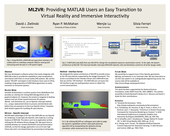Highlight
ML2VR: Providing MATLAB Users an Easy Transition to Virtual Reality and Immersive Interactivity
Achievement/Results
Researchers at the NSF Integrative Graduate Education and Research Training Program (IGERT) on Wireless Intelligent Sensor Networks (WISeNet) at Duke University have developed a software system that easily integrates with MATLAB scripts to provide the capability to view visualizations and interact with them in virtual reality (VR) systems. Responsible for this development are David J. Zielinski, Ryan P. McMahan, Wenjie Lu (WISeNet Associate), and Silvia Ferrari (PI). They call this system “ML2VR” and expect it will introduce more users to VR by enabling a large population of MATLAB programmers to easily transition to immersive systems. MATLAB is a popular computational software system and programming environment that is used in numerous engineering and science programs in the United States. One feature of MATLAB is the capability to generate 3D visualizations, which can be used to visualize scientific data or even to simulate engineering models and processes. Unfortunately, MATLAB provides only limited interactivity for these visualizations. As a solution to this problem, they developed “ML2VR”.
MATLAB researchers are now able to utilize “ML2VR” to easily transition from viewing a 3D surface plot on a desktop computer to viewing and interacting with the plot in a virtual reality system (i.e. CAVE and head-mounted displays), thus enhancing their research. Based on this development, David Zielinski presented “ML2VR: Providing MATLAB Users an Easy Transition to Virtual Reality and Immersive Interactivity” at the following four venues March 2013: Immersive Visualization Bootcamp, Indianapolis, IN, March 25-27, 2013; Poster Presentation at the IEEE Virtual Reality 2013 Conference, Orlando, FL, March 16-23, 2013; Poster Presentation at the Fitzpatrick Institute for Photonics Annual Symposium, Duke University, Durham, NC, March 11-12, 2013; and Visualization Seminar Series – Friday Forum, Duke University, Durham, NC, March 8, 2013. The poster was a candidate for best poster at the IEEE Virtual Reality 2013 conference.
Address Goals
The development of “ML2VR” addresses NSF’s strategic goals of learning and research by providing a cross-platform, open-source software system that easily integrates with MATLAB bringing virtual reality systems to more users. MATLAB researchers will now be able utilize “ML2VR” to easily transition from viewing a 3D surface plot on a desktop computer to viewing and interacting with the plot in a virtual reality system (i.e. CAVE and head-mounted displays), thus enhancing their research.







